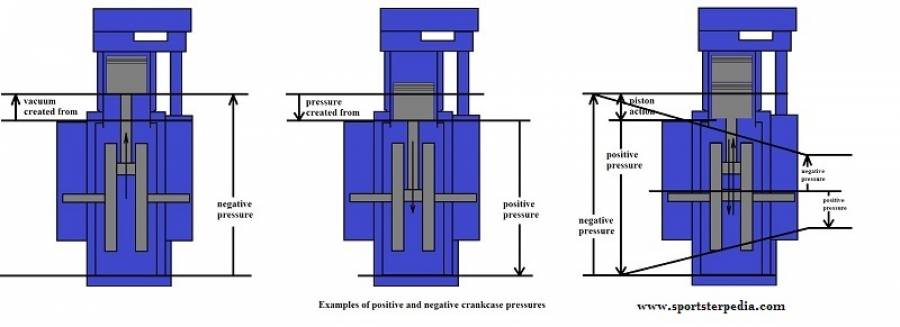REF: Engine Mechanicals - Sub-07A
Example of Air Pulses Using a 1000cc Motor
- Consider the piston actions as they stroke up and down in the top of the cylinders. 1)
- It's the down action that draws fresh intake charge into the cylinders, where it burns propelling you down the road.
- Then the pistons expel the waste as exhaust when they travel up.
- We all know this. 500cc is what each piston 'sweeps'. This all happens on the top side of the pistons.
- That same 500 each (1000 total) is also getting displaced on the underside of the pistons, compressing it into the crankcase.
Instead of into the cylinder head. - Intake and exhaust valves in the cases:
- The piston up and down movement in the cases get pressurized and then 'relaxed'. 2)
(like if you blow into a balloon it pressurizes then breathe in and it relaxes)
- If you take the timing plug out of a running engine, this opens the crankcase to the atmosphere.
- Then you'll get 1000cc of air/oil mixture blowing out of it followed by 1000cc getting sucked back in.
- On 77 and up motors, there are holes through thru the wall separating the crank case from the cam case.
- These holes are the same as 'opening the timing plug'.
- It's the blowing out oil-air that we should address 1st. 3)
- The oil that's getting blown out is oil that got pumped to the big end bearings through the pinion shaft.
(and from the piston squirters on 04 and up models) - The oil did it's thing for the crankpin bearings (and piston lowers) and then flowed out into the case where it mixes with the air in case.
- Mixing isn't really the right term.
Suspended is. - The oil is suspended in the air just like rain water is suspended in air in the wake of a tractor trailer in the rain.
The faster the tractor trailer drives, the better the suspension.
Or, the higher the engine rpm the better the oil suspension.
- The drain down oil from the top end (and oil squirters respectively) is also introduced into the case air but its only a fraction of what came from the crankpin.
(and piston squirters respectively). - This used oil needs to be evacuated (to the oil tank) so that the case doesn't fill up with oil.
- The downstroke of the pistons causes the volume underneath the pistons to decrease which puts positive pressure in the lower end chambers. 4)
- This also puts positive pressure on the oil in the sump.
- This pressure is multi use;
- Then the upstroke of the piston creates an upward negative (vacuum) pressure bringing some of the oil from the sump with it (suspended).
- With little to no (piston ring) blow-by and a check valve on the breather system;
- Crankcase pressure is essentially cycling between (positive and negative pressures) as the pistons go down and back up.
(remember, due to the common crankpin 45 degree design, a Harley motor is a variable volume crankcase, unlike most motors) 5) - This creates splash oil which is bounced about in the crankcase.
This also creates an air / oil mix when tiny particles intertwine with the oil in suspension.
The two don't actually mix as does sugar and water.
So separating them back apart is fairly easy if you add an obstacle for that 'mix' to collide into.
The obstacle is widely known as the timed breather or umbrella valve although anything the mix touches in the motor could accomplish the same thing in theory.
- Instead of the oil-air getting blown into the garage, HD blows & sucks it into the cam chest where it accumulates on the walls of this smallish area. 6)
- Imagine the tractor trailer going into a tunnel.
That suspended rain water will collect on the walls of the tunnel and flow down into the storm drain. - Or, in our case, to the return side of oil pump and then back to oil tank.
The piston motions create a pulsating blast of air pressure (push pull condition as each piston rises and falls).
Static oil pump pressure has already been dissipated by the time it reaches the crankcase.
(although it takes static oil pressure to get the oil from the pump to the crankcase)
Likewise, crankcase (CC) pressure will have an average and constant change in velocity.
Oil in the crankcase adds resistance to the air pressure generated (raising the pressure).
The movement of the pistons and flywheels splash oil around in the engine.
Gravity oil (from the drain ports in the heads) returns to the crankcase or gearcase (respective to year model);
- On 1957-2003 engines, gravity oil from the heads fall into the crankcase.
- On 2004-up engines, gravity oil falls into the cam chest.
Crankcase pressure both pushes to and sucks from the breather valve.
The volume between positive and negative pressure decreases as RPM goes up.
 7)
7)
